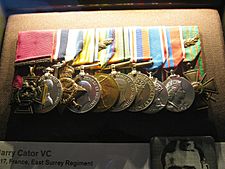Harry Cator facts for kids
Quick facts for kids
Harry Cator
|
|
|---|---|

The medals of Harry Cator on display at the Ashcroft Gallery, Imperial War Museum
|
|
| Born | 24 January 1894 Drayton, Norfolk |
| Died | 7 April 1966 Norwich, Norfolk |
| Buried |
Sprowston Cemetery
|
| Allegiance | |
| Service/ |
|
| Years of service | 1914–1947 |
| Rank | Captain |
| Unit | The East Surrey Regiment Home Guard |
| Battles/wars | World War I World War II |
| Awards | Victoria Cross Military Medal Croix de Guerre (France) |
Harry Cator (born January 24, 1894 – died April 7, 1966) was an incredibly brave English soldier. He received the Victoria Cross, which is the highest award for courage a soldier can get in the United Kingdom and Commonwealth forces. He also earned the Military Medal and the French Croix de Guerre.
Contents
Harry Cator's Early Life
Harry Cator was born in Drayton, a village in Norfolk, England. His father worked on the railway.
After finishing school, Harry worked as a porter on a railway line. Later, he joined a building company in Great Yarmouth.
Serving in World War I
Harry Cator joined the British Army in September 1914, at the start of World War I. By June 1915, he was a sergeant and was sent to the Western Front. This was the main battle area in France and Belgium.
In 1916, during a huge battle called the Somme Offensive, Harry showed great bravery. He brought 36 wounded soldiers back from "no-man's land." This was the dangerous area between the enemy trenches. For this brave act, he was given the Military Medal.
Victoria Cross Heroism
Harry Cator earned the Victoria Cross for his amazing actions during the Arras offensive. This happened on April 9, 1917, near Arras in France.
Harry's group of soldiers, called a platoon, was under heavy attack. Many of his fellow soldiers were hurt by an enemy machine-gun. Harry, with one other soldier, decided to attack the gun. They had to cross an open area, which was very dangerous.
His companion was sadly killed during the attack. But Harry kept going alone. He found a Lewis gun (a type of machine gun) and some ammunition. He managed to reach the enemy trench. There, he saw another enemy machine-gun. Harry bravely killed the entire enemy team and their officer.
He then held that part of the trench by himself. He did such a good job that a group of his own soldiers could capture 100 enemy soldiers and five machine-guns.
After the Battle
A few days after his heroic actions, Harry was injured by an exploding shell. Soon after, it was announced that he would receive the Victoria Cross and the French Croix de Guerre.
Life After the Wars
After World War I ended, Harry Cator worked as a postman. He also worked as a civil servant, which means he worked for the government.
During World War II, Harry Cator served again. He was a captain in the Home Guard. This was a defense organization made up of volunteers in the UK. He was also in charge of a prisoner-of-war camp near Cranwick. This was a camp for enemy soldiers captured during the war.
Harry Cator retired from the Army in December 1947. He passed away on April 7, 1966, in Norwich. He is buried in Sprowston cemetery.
Harry Cator's Legacy
Harry Cator's Victoria Cross and his other medals are on display. You can see them in the Lord Ashcroft Gallery at the Imperial War Museum in London.

